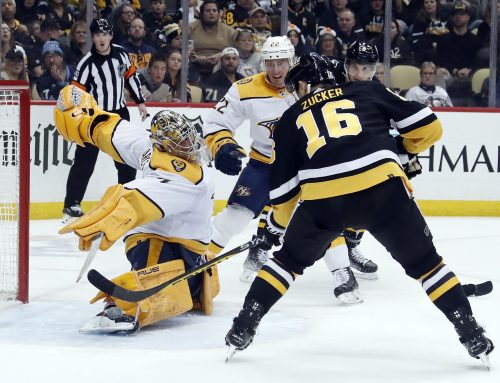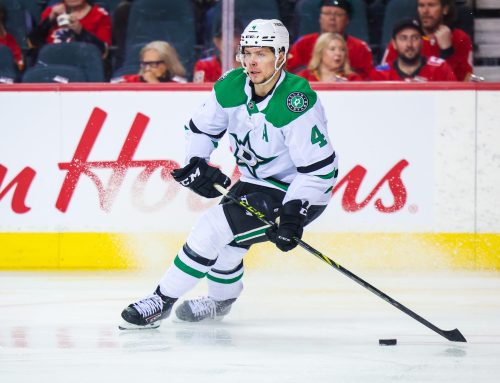Before diving into this article, this is Michael Clifford, one of the editors here at Dobber. Please give a warm welcome to Jamie as he gives us his maiden article for our 'Capped' section. He will be covering 'Capped' from now on, so questions about cap leagues can be directed to him, as well as Alex MacLean. Today, Jamie will be covering his approach to cap leagues, so readers can get a bit of insight into how he operates. Enjoy the article and again, please give Jamie a kudos in the comments if you can!
*
When it comes to having a salary cap in your fantasy hockey leagues, things tend to become a little bit more complex. Things such as drafting, trading, and free agent pickups aren't done as easy and generally take more time to finalize and require deeper levels of thought before executing. There are plenty of ways to prepare yourself for your upcoming fantasy hockey salary cap leagues and I am here to explain them, along with ways to help improve your team's financial management.
Some leagues have different formats, whether they are dynasty leagues, keeper leagues, or have a re-draft format. Then you a have various scoring formats such as, 'points leagues' where the goal is having more points than your opponent by the end of the matchup, and you also have 'category leagues' which is when you are trying to win as many scoring categories as possible to win your fantasy matchup. Some of the things that can count towards your point or category totals include shots on goal, hits, blocks, goals, assists, penalty minutes, powerplay points, shorthanded points, goalie wins, saves, goals against, etc. Every league is different, so before taking advice and laying out a strategy, make sure you're familiar with your league's rules and scoring format.
Most leagues out there usually begin their season with a draft which allows you to draft your favorite players from across the 32 NHL franchises. While it's nice to select the players from your favorite teams and gain points and beat your opponents that way, it may not be the best strategy for a salary cap league. The goal for a salary cap league is to spend your cap space in the smartest way possible; while it's nice to have the players that make $9-million each year, as slam dunks for point-per-game seasons, it doesn't always work out that way. Having that sort of asset is always nice, in a salary cap league they can tend to be considered a one-dimensional asset. What I mean by that is that a lot of NHL players that make that kind of money may produce a lot of goals and assists and not much else in the ways of hits, shots, and other categories that you need to win a matchup, or those same areas that help produce points (based on your league format). While that is very nice to have, and you do need some players who are considered elite point producers at the NHL level. That isn't the only thing that you need to win your league's championship in a salary cap fantasy league. In order to win in a salary cap league, you need to have the players that are performing at a better value than what their contract says. While you need to have top point producers, you also need to have a healthy blend of guys with cheaper contracts mixed into your roster.
From my experience of playing fantasy hockey is that most leagues that have a salary cap do their scoring by the way of categories, which as I stated earlier is when for your matchup you and your opponent are competing to see who wins the most categories for that period. To win a category you need to have the most of something, to win the hits category for example I would need to have my players have more hits than what my opponent's roster did. You can still have a salary cap in points leagues, while it seems less popular from my own personal experiences, they still do exist. In order to win those leagues, you need to have a higher point total than what your opponent does, each individual attribute is worth a certain amount, for example a shot on goal could be worth 0.5 points, and a hit is worth 0.3 points, and a goal could be worth 4 points. At the end of the week whoever has gained the most points are crowned the winner. Both styles of leagues play differently because with categories you desperately need to have players that provide in bulk in a lot of different areas. While in points leagues you can get away with having more players that score goals and assists in bunches to get you towards your goal of winning.
The first step to being successful in your salary cap leagues is to be prepared for the draft, the draft for salary cap leagues is a little different because you see players who would generally get drafted high in other leagues that don't have a salary cap end up being drafted a little bit lower than normal. That has to do with what they bring to the table for how much money they make. One of the more popular examples of a player who doesn't usually carry as much value in salary cap leagues as what they would in non-salary cap leagues is Mitch Marner from TOR. Mitch Marner makes $10.903-million dollars each season and while he is widely considered an elite player in the NHL, his value in salary cap leagues takes a dip because he mainly produces assists, powerplay points, and time on ice. He has average shot totals, he doesn't hit much, he doesn't really block many shots either. When it comes to his career best in those respectively, he has had 233 shots, 41 hits, and 43 blocks. For a player that is going to consume that much of your salary cap you would want them to be contributing a lot more in other areas. Having players who make that much money and who are producing thinly across the categories can hinder you because it impacts what other players you can have.
Preparing for the draft is the most important step, it sets up your team's foundation for the upcoming year and possible into future years as well because most leagues that have a salary cap are keeper leagues. Keeper leagues often have you keep a portion of your roster from year to year, so making the best draft picks possible on draft day can alter your long-term success. There are a lot of resources out there to help you prepare for your drafts, like Capfriendly, which allows you to see a player's salary and their stats. It is a website that a lot of people use to get player information such as salary. When it comes to uncovering a player's stats, a good resource to use is the website known as 'Hockey Reference'. This website provides a clear layout of the stats that would be tracked within your leagues for the most part.
Now that you're starting your research, things that you should be monitoring and keeping note of are how many roster slots you have on your team and what your total budget is. This information allows you to figure out what each roster spot on your team is worth on a per average basis and gives you an idea as to how much you can spend.
The outcome of the season is never usually determined at the draft, there is a lot that can happen during the season like injuries, player demotions, player promotions, slumps, NHL trades and fantasy trades. All of these things will impact your season in some way or another, so you have to be prepared for players not performing at the level in which you expect them to and being prepared for when they are injured. This can be done by having a solid foundation of knowledge for who is in your free agent pool and at what price. When players slump you can drop or trade them, sometimes going for a free agent may be better than a trade because of how much you're trading away may not outweigh the actual statistical value that you're gaining in return. Before you begin trading away players to fill a hole on your roster always explore the free agent pool.
One of the most important things to understand when it comes to salary cap leagues is that while it's nice to load up on the expensive players, it doesn't necessarily help you out. You need to leave room with your salary cap, when it comes time to make trades or drop players and pick up other players. If you don't have the salary cap available to do certain transactions, you are going to be limited in what you can do during the season and being limited in any sense in fantasy hockey is not beneficial.
The key to being successful in salary cap leagues is being able to identify which players make a reasonable amount of money for how they produce. Being able to uncover the players that make a reasonable amount of money for the level of coverage that they provide for you is the biggest learning curve to salary cap fantasy hockey leagues. One comparison that you can view it as is if you're going to the grocery store you want to spend as little as possible and still get the same products in the end. The theory in that statement is if I can get a player who makes $6-million in a season that offers similar enough stats as a $10-million hockey player, why would I want the more expensive guy when that price different can be spent deepening my roster.
Being able to work with the salary cap effectively is one of the biggest assets that you can have as a manager of a fantasy hockey team, these are some of the thoughts that you can have to be prepared for your salary cap league.
Twitter: @JamieMolloy_DH





 FLA
FLA CHI
CHI NYR
NYR PIT
PIT L.A
L.A COL
COL CAR
CAR UTA
UTA SEA
SEA
 NYI
NYI TOR
TOR VAN
VAN S.J
S.J
